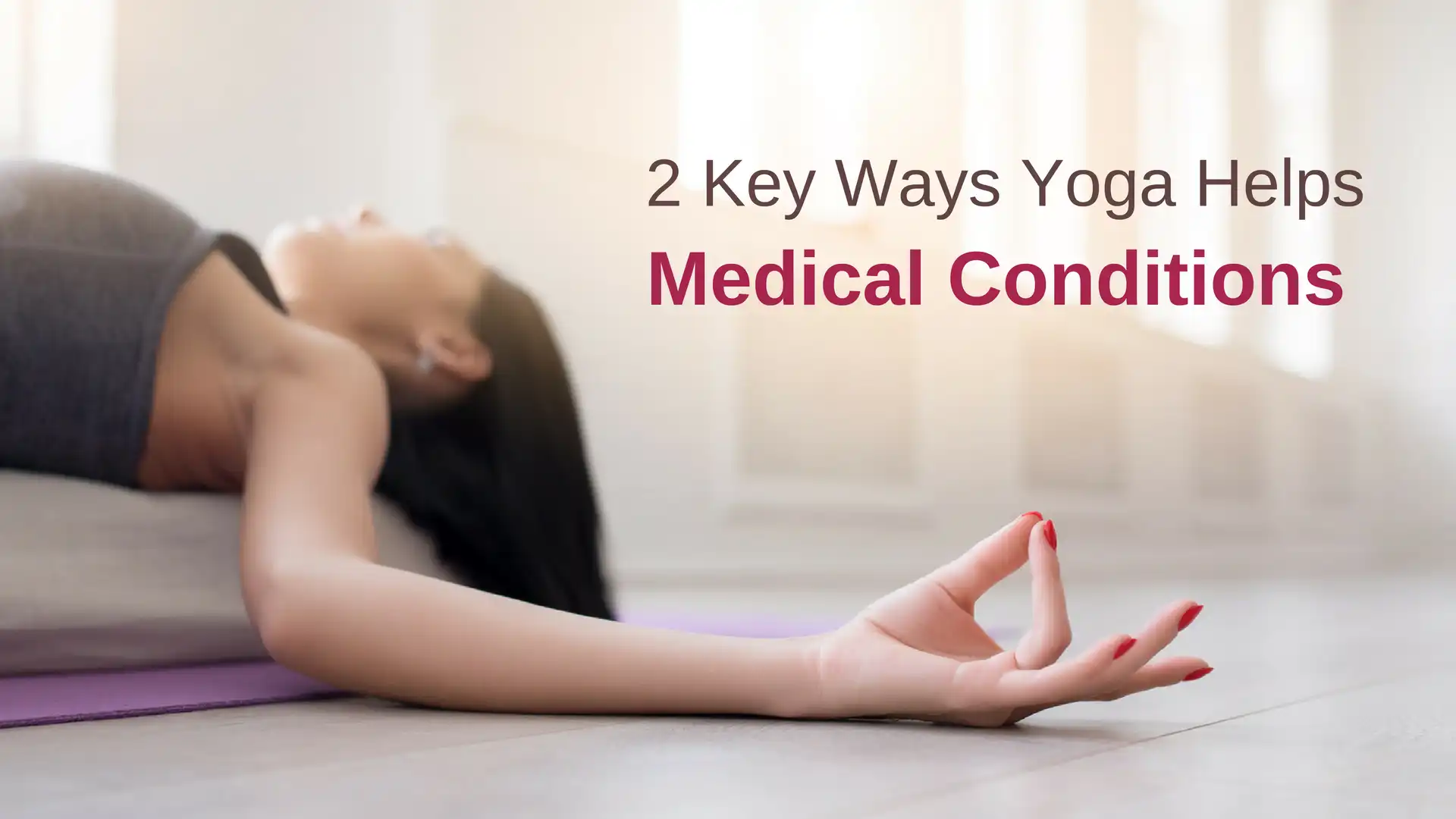How Yoga Helps with Medical Conditions: Symptom Improvement

Symptoms of medical conditions and injuries can cause daily stress and decrease our quality of life. Yoga practice can reduce symptoms of medical conditions, and can, in some cases, cure the underlying condition that causes the symptoms. Here’s how:
1. Relieve symptoms caused by a medical condition without curing it. In this case, although you’re not curing the medical condition; you’re using yoga to achieve either temporary or long-term improvement of symptoms. For example, someone with chronic low back pain from a ruptured disc can use yoga very effectively to reduce or relieve pain. But because yoga cannot repair the ruptured disc, the underlying condition isn’t cured and may occasionally still produce pain.
2. Relieve symptoms and cure a medical condition with yoga alone. This means that you are using yoga to resolve the symptoms caused by your underlying condition but you are also using it to resolve the underlying disorder itself, so it is unlikely to return. For example, someone with stress-related headaches could use yoga’s pain management techniques to reduce headache pain and yoga’s stress management techniques to eliminate the headaches themselves.
Now let’s take a closer look at these two different ways you can use yoga for improving symptoms.
Yoga for Symptom Improvement Alone
Yoga is extremely effective for providing symptom improvement for a large number of medical conditions, even if it does not lead to a cure. Typically you use a combination of tools for symptom improvement, including asana (active, gentle, restorative and supported inversions), stress management tools, and equanimity tools such as meditation and breathing practices. Since yoga has the potential to improve the symptoms of just about any medical condition, here are just a few examples:
1. Respiratory conditions, such as emphysema and chronic cough. See 4 Ways Yoga Fosters Respiratory System Health for information on using yoga for respiratory system health.
2. Chronic pain, such as chronic low back pain and fibromyalgia, and post recovery from surgery. Read Three Different Ways Yoga Helps with Pain for using yoga for pain management.
3. Immune-related conditions, such as rheumatoid arthritis, multiple sclerosis, and HIV/Aids. See 4 Ways Yoga Helps Your Immune System for using yoga to support the immune system and How Yoga Helps with Pain for pain relief.
4. Digestive conditions that are aggravated by stress, such as irritable bowel syndrome and peptic ulcer disease. See Digestive Trouble? 7 Ways Yoga Can Help for information on using yoga to support your digestive system.
5. Cardiovascular conditions, such as coronary artery disease and irregular heart rhythms. (Of course, while avoiding practices that could aggravate the condition, such as vigorous styles of asana practice, long-held standing poses, and full inversions.)
6. Emotional illness, such as anxiety and depression.
7. Brain conditions that lead to worsening cognitive function, such as early-stage dementia and mini strokes as a complication of diabetes.
8. Palliative care (including pain management and stress reduction) for those who do not want to use Western medical options, such as for end-of-life care.
Yoga for Symptom Improvement with Curing
Although there are actually very few conditions that yoga can cure by itself (most complete healing with yoga occurs when yoga is used as an adjunct to other forms of care), there are five categories of medical conditions that yoga alone can potentially cure:
1. Musculoskeletal Conditions. These include acute minor injuries such as common sprains and strains, and a certain subset of more significant acute injuries, including back and neck pain. Combining asanas for physical benefits with mindfulness techniques and stress management techniques can promote tissue healing.
2. Stress-Related Headaches. For some people, yoga’s stress management tools can resolve stress headaches.
3. Unhealthy Breathing Patterns. Yoga’s tools for cultivating the health of your respiratory system can reverse some abnormal breathing patterns.
4. Stress-Related Digestive Problems. Stress management techniques can resolve some minor digestive problems that are caused by stress.
5. Emotional Conditions. For certain people with mild forms of chronic stress, anxiety and depression, combining asanas for emotional well-being with yoga’s stress management and equanimity tools can resolve emotional problems.
For now, our evidence on the ability of yoga to “cure” many of these conditions is anecdotal (reported by individuals, not proved in a scientific study). However, we have seen so many people benefit from using yoga to help with these conditions that until we do have studies to back us up, we recommend giving yoga a try.
In general, however, before you attempt to address a particular medical condition with yoga, I recommend that you get guidance from both an experienced yoga teacher or yoga therapist and your doctor. And keep in mind that unlike when you have been prescribed an antibiotic to cure a specific infection, you can’t use yoga for two weeks to cure these conditions and then just discard it. For many of these conditions, part of a “yoga cure” involves ongoing maintenance.
For example, if you successfully used your yoga tools to heal an acute bout of lower back pain, your use of yoga to maintain your improvement would not stop there, as returning to your old habits that may have contributed to the back pain in the first place could bring it back. So from that point on, you would use your yoga practice to maintain the healing you have achieved and reduce the chances of re-injury.
Finally, before pronouncing yourself “cured,” we recommend that you monitor your condition for a reasonable amount of time, say one to two years, especially if you are dealing with a more complex issue, such a severe low back pain or depression.
In fact, for many of these conditions, yoga alone may not be enough to bring about a cure. So you may need to combine yoga with strategies that your doctor recommends, such as specific physical therapy exercises for that ankle or appropriate antidepressant medications for that depression. This is especially true for many emotional conditions. For emotional conditions that are more severe or that just do not seem to responding quickly to your practice, I strongly recommend that you combine yoga with other forms of treatment, such as therapy or medication.
In these situations, yoga is acting as an adjunct to your western medical treatment, which I will get into in more detail a little later. Yoga is a great complement to Western medicine. The ultimate goal is your ongoing wellness!
The Bottom Line
Keep in keep in mind that there are no guarantees for using yoga either for improving symptoms or curing a medical condition. However, the mounting evidence that yoga at the very least improves symptoms for many conditions should encourage you to give it a try!
Study with Dr. Baxter Bell and YogaUOnline – Yoga for Digestive Health.
Also from YogaUOnline and Baxter Bell, MD and Nina Zolotow – Yoga Therapy: How to Target Your Yoga Practice For Prevention.
This article originally appeared on Yoga for Healthy Aging. Reprinted with permission.
 Baxter Bell, MD, is a yoga teacher and educator, physician and medical acupuncturist. These days he focuses on teaching yoga full time, both to ordinary students of all ages and physical conditions, and to the next generation of yoga teachers, to whom he teaches anatomy and yoga therapy along with his accessible, skillful style of yoga. Baxter brings a unique perspective to his teaching, combining his understanding of anatomy and medicine with his skill at instructing people from all walks of life and all levels of ability. Baxter is the co-founder and writer for the popular Yoga for Healthy Aging blog, where he shares his knowledge of medical conditions, anatomy, and yoga with practitioners and teachers across the world. In addition to being a frequent presenter at Yoga Journal Alive events and yoga conferences such as IAYT’s SYTAR, he is often quoted as an expert on yoga and health by major national news outlets such as The Washington Post and Wall Street Journal. To learn more, visit www.baxterbell.com, www.yogaforhealthyaging.blogspot.com, and his YouTube channel Baxter Bell Yoga.
Baxter Bell, MD, is a yoga teacher and educator, physician and medical acupuncturist. These days he focuses on teaching yoga full time, both to ordinary students of all ages and physical conditions, and to the next generation of yoga teachers, to whom he teaches anatomy and yoga therapy along with his accessible, skillful style of yoga. Baxter brings a unique perspective to his teaching, combining his understanding of anatomy and medicine with his skill at instructing people from all walks of life and all levels of ability. Baxter is the co-founder and writer for the popular Yoga for Healthy Aging blog, where he shares his knowledge of medical conditions, anatomy, and yoga with practitioners and teachers across the world. In addition to being a frequent presenter at Yoga Journal Alive events and yoga conferences such as IAYT’s SYTAR, he is often quoted as an expert on yoga and health by major national news outlets such as The Washington Post and Wall Street Journal. To learn more, visit www.baxterbell.com, www.yogaforhealthyaging.blogspot.com, and his YouTube channel Baxter Bell Yoga.
 Nina Zolotow, RYT 500, Editor-in-Chief of the Yoga for Healthy Aging blog, is both a yoga writer and a yoga teacher. She trained to be a yoga teacher at The Yoga Room in Berkeley, California, has studied yoga therapy with Shari Ser and Bonnie Maeda, and is especially influenced by the teachings of Donald Moyer. She also studied extensively with Rodney Yee, and is inspired by the teachings of Patricia Walden on yoga for emotional healing. Her special area of expertise is yoga for emotional well-being (including yoga for stress, insomnia, depression, and anxiety) and she teaches workshops and series classes on yoga for emotional wellbeing, stress management, better sleep, home practice, and cultivating equanimity. Nina is the co-author, with Rodney Yee, of two books on yoga: Yoga: The Poetry of the Body and Moving Toward Balance, both of which are widely available, and is currently writing a book with Baxter Bell on Yoga for Healthy Aging for publication in 2017.
Nina Zolotow, RYT 500, Editor-in-Chief of the Yoga for Healthy Aging blog, is both a yoga writer and a yoga teacher. She trained to be a yoga teacher at The Yoga Room in Berkeley, California, has studied yoga therapy with Shari Ser and Bonnie Maeda, and is especially influenced by the teachings of Donald Moyer. She also studied extensively with Rodney Yee, and is inspired by the teachings of Patricia Walden on yoga for emotional healing. Her special area of expertise is yoga for emotional well-being (including yoga for stress, insomnia, depression, and anxiety) and she teaches workshops and series classes on yoga for emotional wellbeing, stress management, better sleep, home practice, and cultivating equanimity. Nina is the co-author, with Rodney Yee, of two books on yoga: Yoga: The Poetry of the Body and Moving Toward Balance, both of which are widely available, and is currently writing a book with Baxter Bell on Yoga for Healthy Aging for publication in 2017.



